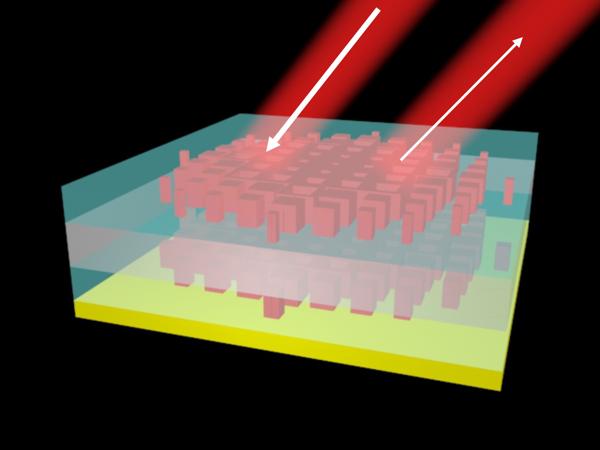When light is reflected by a mirror, the tangential components of the momentum of incident light and reflected light are the same. On the contrary, a retroreflector flips the direction of incident light, and the light will be reflected back along the incident direction. This characteristic means that the reflected light from the retroreflector can be collected at the same position from where it is emitted.
Moreover, the reflected light can be modulated and loaded with information before it returns. As a result, retroreflectors are very important components in communications, remote sensing, laser tracking and so on. Conventional retroreflectors rely on the utilization of macroscopic geometrical structures, such as a corner-cube retroreflector and Eaton lens. They are bulky and nonplanar that are inconveniently compatible for integration and miniaturization.
Metasurfaces, planar artificial materials, have recently shown great promise for building flat ultrathin retroreflectors that demonstrate their superiority over conventional schemes in terms of compactness and integration. Plasmonic metasurfaces have been used to realize retroreflection, but the resultant experiment exhibits limited working bandwidth and/or a single incidence angle since the provided tangential momenta corresponding to their periods are fixed after the fabrication process.
To address the issue of limited working incidence angle, reconfigurable plasmonic metasurfaces have been proposed and demonstrated, which realize spin-polarized retroreflection with a discrete/continuous angle of incidence at a single frequency as their periods are adjustable. In addition, analogous to conventional cat's eye retroreflectors, it has been proposed to employ two cascaded gradient metasurfaces to realize a retroreflector. The first metasurface focus the light with different incidence angle θ to different positions on the second metasurface and the second metasurface provides a corresponding change in the tangential component of momentum, to the light. The retroreflector has shown the capability of retroreflecting light over a continuous angle at a single frequency.
However, all of the aforementioned schemes undergo narrow bandwidth, which limits practical applications, as the device bandwidth is crucial for an optical system. To date, realizing an optical metasurface retroreflector with a broad operation bandwidth, continuous incidence angles, and polarization independence remains largely unexplored.
The research group led by prof. Lin Chen from Huazhong University of Science and Technology introduces a near-infrared broadband retroreflector by use of two layers of achromatic gradient metasurfaces in Chinese Optics Letters, Vol. 19, No. 2, 2021(Ming Deng, Tangxuan Ren, Jian Wang, Lin Chen. Doublet achromatic metalens for broadband optical retroreflector[J]. Chinese Optics Letters, 2021, 19(2): 023601).

Schematic of a broadband retroreflector comprised of a transmissive achromatic metasurface combined with a reflective achromatic metasurface
Compared with the aforementioned two-layered metasurface retroreflector, the achromatic metasurfaces used in this work realize corresponding functions in a broad bandwidth. The incident light independent of wavelength with different incidence angle is focused to different positions on the second achromatic metasurface by the first one. The change in tangential component of momentum provided by the second achromatic metasurface is dependent on incidence angle and wavelength.
The retroreflector provides a high-performance retroreflection for polarization-independent incident light waves over a continuous range of incidence angles within an extremely broad wavelength range. The presented results point out a promising avenue to design complex metasurface photonic devices that are broadband and polarization friendly. Furthermore, a broadband retroreflector for wide range of incidence angles in the visible may be constructed in the future.


